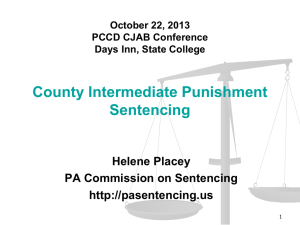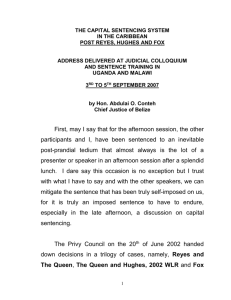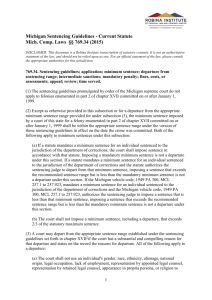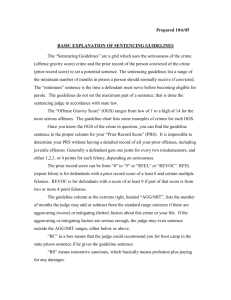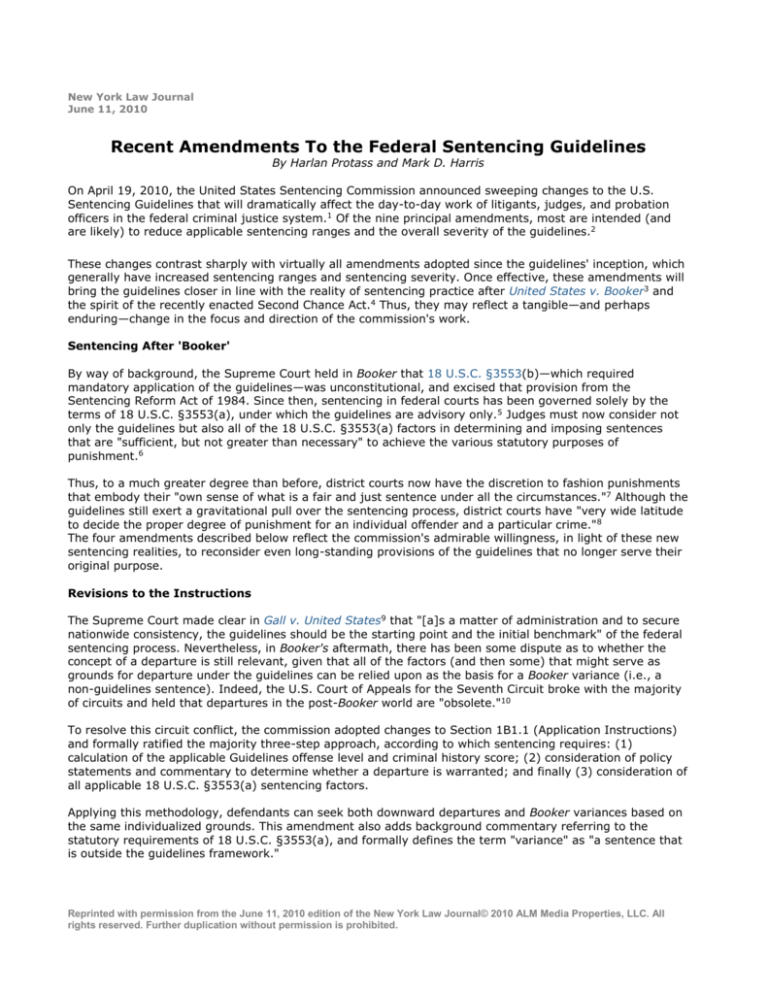
New York Law Journal
June 11, 2010
Recent Amendments To the Federal Sentencing Guidelines
By Harlan Protass and Mark D. Harris
On April 19, 2010, the United States Sentencing Commission announced sweeping changes to the U.S.
Sentencing Guidelines that will dramatically affect the day-to-day work of litigants, judges, and probation
officers in the federal criminal justice system.1 Of the nine principal amendments, most are intended (and
are likely) to reduce applicable sentencing ranges and the overall severity of the guidelines.2
These changes contrast sharply with virtually all amendments adopted since the guidelines' inception, which
generally have increased sentencing ranges and sentencing severity. Once effective, these amendments will
bring the guidelines closer in line with the reality of sentencing practice after United States v. Booker3 and
the spirit of the recently enacted Second Chance Act.4 Thus, they may reflect a tangible—and perhaps
enduring—change in the focus and direction of the commission's work.
Sentencing After 'Booker'
By way of background, the Supreme Court held in Booker that 18 U.S.C. §3553(b)—which required
mandatory application of the guidelines—was unconstitutional, and excised that provision from the
Sentencing Reform Act of 1984. Since then, sentencing in federal courts has been governed solely by the
terms of 18 U.S.C. §3553(a), under which the guidelines are advisory only.5 Judges must now consider not
only the guidelines but also all of the 18 U.S.C. §3553(a) factors in determining and imposing sentences
that are "sufficient, but not greater than necessary" to achieve the various statutory purposes of
punishment.6
Thus, to a much greater degree than before, district courts now have the discretion to fashion punishments
that embody their "own sense of what is a fair and just sentence under all the circumstances."7 Although the
guidelines still exert a gravitational pull over the sentencing process, district courts have "very wide latitude
to decide the proper degree of punishment for an individual offender and a particular crime." 8
The four amendments described below reflect the commission's admirable willingness, in light of these new
sentencing realities, to reconsider even long-standing provisions of the guidelines that no longer serve their
original purpose.
Revisions to the Instructions
The Supreme Court made clear in Gall v. United States9 that "[a]s a matter of administration and to secure
nationwide consistency, the guidelines should be the starting point and the initial benchmark" of the federal
sentencing process. Nevertheless, in Booker's aftermath, there has been some dispute as to whether the
concept of a departure is still relevant, given that all of the factors (and then some) that might serve as
grounds for departure under the guidelines can be relied upon as the basis for a Booker variance (i.e., a
non-guidelines sentence). Indeed, the U.S. Court of Appeals for the Seventh Circuit broke with the majority
of circuits and held that departures in the post-Booker world are "obsolete."10
To resolve this circuit conflict, the commission adopted changes to Section 1B1.1 (Application Instructions)
and formally ratified the majority three-step approach, according to which sentencing requires: (1)
calculation of the applicable Guidelines offense level and criminal history score; (2) consideration of policy
statements and commentary to determine whether a departure is warranted; and finally (3) consideration of
all applicable 18 U.S.C. §3553(a) sentencing factors.
Applying this methodology, defendants can seek both downward departures and Booker variances based on
the same individualized grounds. This amendment also adds background commentary referring to the
statutory requirements of 18 U.S.C. §3553(a), and formally defines the term "variance" as "a sentence that
is outside the guidelines framework."
Reprinted with permission from the June 11, 2010 edition of the New York Law Journal© 2010 ALM Media Properties, LLC. All
rights reserved. Further duplication without permission is prohibited.
Shifting the Sentencing Table
The commission reconfigured the sentencing table, expanding Zones B and C by one offense level for each
criminal history category (taking areas from Zones C and D, respectively). Accordingly, defendants in Zone
C with an applicable guidelines range of 8-14 or 9-15 months are now eligible to have their entire sentences
served in community confinement or home detention, and defendants in Zone D with an applicable range of
12-18 months are eligible for a "split sentence" requiring only half the time to be spent in prison and the
other half in an alternative setting.
This amendment grew out of the commission's multi-year study of alternatives to incarceration, which was
prompted by an unusual confluence of several factors—increased interest in alternatives by all three
branches of government, renewed public debate about the size of the federal prison population, and the
need for greater availability of alternatives to imprisonment for certain non-violent first-time offenders. If
implemented, this change will have an immediate real-world effect.
The commission estimates that of the 71,054 individuals sentenced in 2009, 1,565 offenders in Zone C (or
2.2 percent) would have been in Zone B, and 2,734 offenders in Zone D (or 3.8 percent) would have been in
Zone C (although not all of them would have been eligible for a non-prison sentence).
In addition, the commission amended an application note to state specifically that there may be cases in
which a departure from the sentencing options authorized by Zone B or C is appropriate to accomplish a
specific treatment purpose. The commission noted, however, that such departures should be considered
only in cases in which a court finds that the defendant has a substance abuse problem or suffers from
significant mental illness and is convicted of an offense related to that treatment problem.
Offender Characteristics
Chapter Five, Part H currently lists eight offender characteristics that are "not ordinarily relevant" in
determining whether a departure from the applicable guidelines range is warranted. (Chapter 5, Part K lists
numerous other grounds relevant to departure decisions, both upward and downward.) Partly in response to
the reality that district courts have been relying on these characteristics as grounds for Booker variances,
the commission recharacterized four of them, stating that they "may be relevant" to the departure analysis
when they are "present to an unusual degree and distinguish[] the case from the typical cases covered by
the guidelines."
Specifically, the commission recognized that age (including youth), mental and emotional conditions,
physical condition or appearance, and prior military service now "may be relevant" in determining whether a
departure is appropriate. The fourth change—military service—was adopted seemingly in reaction to a 2009
Supreme Court decision recognizing that "[o]ur nation has a long tradition of according leniency to veterans
in recognition of their service, especially for those who fought in the front lines."11
Oddly, the commission endorsed that view, agreeing that service has been recognized as a "traditional"
mitigating factor at sentencing, even though previous guidelines manuals had always characterized it as
"not ordinarily relevant" to the departure analysis. As to the other three offender characteristics, the
commission offered vague reasons for the amendments, stating only that it adopted them after "reviewing
recent federal sentencing data, trial and appellate court case law, scholarly literature, public comment and
testimony, and feedback in various forms from federal judges." More detailed insight into the commission's
reasons for these changes would be helpful to both practitioners and judges.
While welcome news to those troubled by the previous, overly-mechanistic approach to sentencing, these
amendments highlight the enduring tension between the provisions of 18 U.S.C. §3553(a), which requires
sentencing courts to consider the "history and characteristics" of every defendant, and the guidelines'
overall goal of avoiding unwarranted sentencing disparity based on individualized sentencing
determinations.
Indeed, the changes leave intact for now several offender-specific factors (education and vocational skills,
employment record, family ties and responsibilities, and lack of guidance as a youth and similar
circumstances) that the commission continues to maintain are "not ordinarily relevant" to departure
decisions.
Reprinted with permission from the June 11, 2010 edition of the New York Law Journal© 2010 ALM Media Properties, LLC. All
rights reserved. Further duplication without permission is prohibited.
'Recency' Provision
Section 4A1.1 currently lists several factors that courts must consider in calculating a defendant's criminal
history score, including: (1) prior sentences of imprisonment; (2) whether the defendant committed the
offense while on probation, parole, supervised release, imprisonment, work release, or escape status; and
(3) the proximity in time of the current offense to any prior offense.
As part of its review leading up to this year's round of revisions, the commission analyzed whether the final
factor on the list above—so-called recency points—accurately predicts recidivism risk. And its findings were
surprising. In particular, the commission found that recency only "minimally improves" the ability to predict
whether or not a defendant will recidivate. Rather, it concluded that, while defendants who recidivate tend
to do so relatively soon after being released from prison, they do so because of the challenges to successful
reentry after imprisonment, not increased culpability.
As a result, the commission eliminated the recency provision. Criminal defendants will no longer receive
criminal history points for offenses committed less than two years after release from imprisonment for
offenses that resulted in prison terms longer than sixty days or while in imprisonment or escape status on
such a sentence.
This revision again demonstrates the commission's commitment to reexamining the efficacy of particular
guidelines, as well as the reality that criminal history issues have often been cited by sentencing courts as
reasons for imposing below-range sentences.
Sentencing of Organizations
The commission made modest but meaningful changes to the organizational sentencing guidelines, primarily
aimed at encouraging compliance and ethics programs. The typical form of punishment for an organization
(defined as "any person other than an individual," and including corporations, unions, partnerships, and
even governments) convicted of criminal conduct is a fine, although organizations may also be ordered to
pay restitution, perform community service, or remedy the harm they have caused in some other manner.
As with the guidelines for individual offenders, a variety of aggravating and mitigating factors contribute to
the proper calculation of the appropriate fine range for an organization. Besides after-the-fact corrective
measures (self-reporting, cooperation, and acceptance of responsibility), the key mitigating factor for an
organization is the existence of an effective compliance and ethics program.
The amendments give greater force to such programs. Under the current guidelines, a compliance and
ethics program would not count in favor of an organization if "high-level personnel" or those with
"substantial authority" were involved in the offense. The amendments restore the possibility of leniency in
such cases so long as the organization is structured so that the individuals who have operational authority
for the compliance program have direct reporting obligations to the organization's governing authority.
On the flip side, the amendments also require that an organization seeking leniency take real steps to
remedy the harm caused by its criminal conduct (including by offering restitution to victims where
appropriate) and modify its compliance program if needed (such as by use of an outside professional
advisor).
Conclusion
The commission's current round of amendments demonstrates the ongoing evolution of the guidelines
system. The changes they implement are clearly designed to reflect the reality of how judges are actually
sentencing, and at the same time to influence and shape that process. How those institutional motivations
will continue to interact remains one of the most interesting questions about the future of the guidelines.
Harlan Protass is a criminal defense lawyer in New York and an adjunct professor at the Benjamin N.
Cardozo School of Law, where he teaches sentencing law. Mark D. Harris is a partner in the litigation and
dispute resolution department of Proskauer Rose, where he practices criminal defense and is co-head of the
appellate practice group.
Reprinted with permission from the June 11, 2010 edition of the New York Law Journal© 2010 ALM Media Properties, LLC. All
rights reserved. Further duplication without permission is prohibited.
Endnotes:
1. The commission's proposed changes will go into effect on Nov. 1, 2010, unless Congress disapproves
them.
2. The full text of the guidelines amendments discussed in this article may be found at
http://www.ussc.gov/2010guid/finalamend10.pdf.
3. 543 U.S. 220 (2005).
4. 42 U.S.C. §17501, et seq.
5. 18 U.S.C. §3553(a)(4); United States v. Crosby, 397 F.3d 103, 113 (2d Cir. 2005).
6. Booker, 543 U.S. at 245-46; Crosby, 397 F.3d at 112-14.
7. United States v. Jones, 460 F.3d 191, 195 (2d Cir. 2006).
8. United States v. Cavera, 550 F.3d 180, 188-89 (2d Cir. 2008) (en banc).
9. 552 U.S. 38 (2007).
10. United States v. Johnson, 427 F.3d 423 (7th Cir. 2006).
11.Porter v. McCollum, 130 S.Ct. 447, 455 (2009).
Reprinted with permission from the June 11, 2010 edition of the New York Law Journal© 2010 ALM Media Properties, LLC. All
rights reserved. Further duplication without permission is prohibited.




